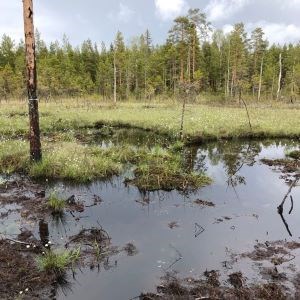This research program studies how wetland restoration affects multiple aspects e.g. water holding capacity, water quality, greenhouse gas balance, biodiversity, infectious diseases, spruce bark beetles and other pest infestations, and forest recreational values.
Background
Sweden has extensively drained forest wetlands over the last 150 years to improve forest productivity. However, draining has negatively affected biodiversity, carbon sequestration, risks for downstream flooding, and forest growth resilience.
In a future climate, retaining extensive drained forests may
- increase risks of forest fires, droughts and floods;
- further increase CO2 emissions, degradation of biodiversity, water quality and opportunities for humans to experience and understand healthy ecosystems;
- contribute to new or more frequent outbreaks of infectious deceases;
- and escalate the spread and damage of bark beetle and other pests.
There is strong societal interest in reversing these risks by restoring drained wetlands. But is it possible to fully recover the many environmental and societal benefits associated with natural wetlands? And can restoration lead to any yet poorly understood environmental or societal risks?
Aim
Potential risks of wetland restoration have been insufficiently considered and explored. Existing research typically studied different aspects separately. This program studies how wetland restoration affects multiple aspects in the same experimental design, including 20 wetland restorations and 20 drained references wetlands, with varied landscape and design factors. The overall aim of this program is to determine where and how wetlands can be restored to maximize benefits and reduce negative impacts.
Subprojects
We will achieve our aim through a series of specific objectives connected to eight subprojects (SP) including one coordinating subproject (SP1).
The SP:s will evaluate where (landscape type) and how (design features) wetland restoration are most likely to:
- improve the water holding capacity in the wetland and surrounding soils (SP2)
- improve, or at least maintain, water quality in downstream waters, including methylmercury (MeHg), organic carbon (OC), and nutrient concentrations (SP3)
- reduce net GHG emissions (SP4)
- increase biodiversity and reduce vector-borne and zoonotic pathogens (SP5)
- reduce spruce bark beetle and other pest infestations (SP6)
- enhance environmental values for human recreation (SP7)
Furthermore, the program will:
- use data from SP2-SP3 to model the potential of wetland restoration to improve water holding capacity and water quality in a landscape scale and in a future climate (SP8).
The overall project (SP1) will:
- create a planning tool based on an integrated assessment, to guide decisions on where and how to restore wetlands to maximize benefits and reduce negative impact for the environment and society.
Participants
Program leader
- Karin Eklöf, Department of Aquatic Sciences and Assessment, SLU
Subproject (SP) leaders
- SP1 Coordinating project – Subproject leader: Karin Eklöf, SLU
- SP2 Water retention and drought/flood control – Subproject leader: Hjalmar Laudon, SLU
- SP3 Surface water quality – Subproject leader: Marcus Wallin, SLU
- SP4 Carbon and GHG balance – Subproject leader: Järvi Järveoja, SLU
- SP5 Biodiversity and vector-borne and zoonotic pathogens - Subproject leader: Frauke Ecke, University of Helsinki
- SP6 Spruce bark beetles and other pest infestations – Subproject leader: Simon Kärvemo, SLU
- SP7 Human recreation and wellbeing - Subproject leader: Freddie Lymeus, Uppsala University
- SP8 Modelling wetland restoration effects in a landscape and future climate perspective –Subproject leader: Maria Elenius, SMHI
Other participants
Funding
This project is funded by the Swedish Environmental Protection Agency, the Environmental research fund.
